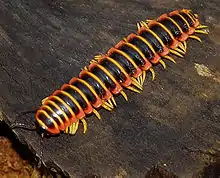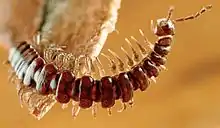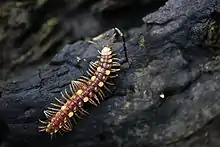Polydesmida
Polydesmida (from the Greek poly "many" and desmos "bond") is the largest order of millipedes, containing approximately 3,500 species,[2] including all the millipedes reported to produce hydrogen cyanide (HCN).[3]
| Polydesmida | |
|---|---|
 | |
| Apheloria virginiensis | |
| Scientific classification | |
| Kingdom: | |
| Phylum: | |
| Subphylum: | |
| Class: | |
| Superorder: | Merocheta Cook, 1895 |
| Order: | Polydesmida |
| Suborders | |
| |
| Synonyms | |
|
Proterospermatophora Verhoeff, 1900 | |
Description
Members of the order Polydesmida are also known as "flat-backed millipedes", because on most species, each body segment has wide lateral keels known as paranota.[4] These keels are produced by the posterior half (metazonite) of each body ring behind the collum.[5] Polydesmids have no eyes, and vary in length from 3 to 130 mm (0.12 to 5.12 in).[6] Including the telson, adults have 19 or 20 rings, while juveniles may have from 7 to 19 rings.[5] Mature males have a single pair of gonopods consisting of the modified forward leg pair of the 7th segment.[7] Many of the larger species show bright coloration patterns which warn predators of their toxic secretions.[7]
Ecology
Polydesmids are very common in leaf litter, where they burrow by levering with the anterior end of the body.[4]
Classification
The c. 3500 species of Polydesmida are variously classified into four suborders (names ending in "-idea"), and 29 families, the largest (numerically) including Paradoxosomatidae, Xystodesmidae, and Chelodesmidae.[2]
- Dalodesmidea Hoffman, 1980. 2 families
- Dalodesmidae Cook, 1896
- Vaalogonopodidae Verhoeff, 1940
- Leptodesmidea Brölemann, 1916. 13 families
- Chelodesmoidea Cook, 1895
- Chelodesmidae Cook, 1895
- Platyrhacoidea Pocock, 1895
- Aphelidesmidae Brölemann, 1916
- Platyrhacidae Pocock, 1895
- Rhachodesmoidea Carl, 1903
- Rhachodesmidae Carl, 1903
- Tridontomidae Loomis & Hoffman, 1962
- Sphaeriodesmoidea Humbert & de Saussure, 1869
- Campodesmidae Cook, 1896
- Holistophallidae Silvestri, 1909
- Sphaeriodesmidae Humbert & de Saussure, 1869
- Xystodesmoidea Cook, 1895
- Eurymerodesmidae Causey, 1951
- Euryuridae Pocock, 1909
- Gomphodesmidae Cook, 1896
- Oxydesmidae Cook, 1895
- Xystodesmidae Cook, 1895
- Paradoxosomatidea Daday, 1889.[lower-alpha 1] 1 family
- Paradoxosomatidae Daday, 1889
- Polydesmidea Pocock, 1887. 12 families
- Oniscodesmoidea Simonsen, 1990
- Dorsoporidae Loomis, 1958
- Oniscodesmidae DeSaussure, 1860
- Pyrgodesmoidea Silvestri, 1896
- Ammodesmidae Cook, 1896
- Cyrtodesmidae Cook, 1896
- Pyrgodesmidae Silvestri, 1896
- Haplodesmoidea Cook, 1895
- Haplodesmidae Cook, 1895
- Opisotretoidea Hoffman, 1980
- Opisotretidae Hoffman, 1980
- Polydesmoidea Leach, 1815
- Cryptodesmidae Karsch, 1880
- Polydesmidae Leach, 1815
- Trichopolydesmoidea Verhoeff, 1910
- Fuhrmannodesmidae Brölemann, 1916
- Macrosternodesmidae Brölemann, 1916
- Nearctodesmidae Chamberlin & Hoffman, 1958
- Trichopolydesmidae Verhoeff, 1910
- Representative diversity of Polydesmida
.jpg.webp) Asiomorpha coarctata (Paradoxosomatidae), an Asian species widely introduced by humans
Asiomorpha coarctata (Paradoxosomatidae), an Asian species widely introduced by humans Tasmaniosoma armatum (Dalodesmidae) from Tasmania
Tasmaniosoma armatum (Dalodesmidae) from Tasmania.JPG.webp) Eutrichodesmus aster (Haplodesmidae) from Vietnam, with unusual mid-dorsal crests
Eutrichodesmus aster (Haplodesmidae) from Vietnam, with unusual mid-dorsal crests.jpg.webp) A species of Xystodesmidae from the United States showing aposematic coloration
A species of Xystodesmidae from the United States showing aposematic coloration.jpg.webp) A paradoxosomatid from China, with reduced paranota
A paradoxosomatid from China, with reduced paranota Polydesmus collaris (Polydesmidae) from Europe
Polydesmus collaris (Polydesmidae) from Europe
References
- synonym: Strongylosomatidea Brölemann, 1916
- Robert Mesibov (2005). "A new genus of millipede (Diplopoda: Polydesmida: Dalodesmidae) from Tasmania with a pseudo-articulated gonopod telopodite" (PDF). Zootaxa. 1064: 39–49.
- Shear, W (2011). Zhang, Z.-Q. (ed.). Class Diplopoda de Blainville in Gervais, 1844. In: Animal biodiversity : an outline of higher-level classification and survey of taxonomic richness (PDF). Zootaxa. pp. 159–164. ISBN 978-1-86977-850-7.
- Thomas Eisner (2005). "Vinegaroons and other wizards". For Love of Insects. Harvard University Press. pp. 44–73. ISBN 978-0-674-01827-3.
- Colin Little (1983). "Onychophorans and myriapods". The Colonisation of Land: Origins and Adaptations of Terrestrial Animals. Cambridge University Press. pp. 127–145. ISBN 978-0-521-25218-8.
- J. Gordon Blower (1985). "Order Polydesmida". Millipedes: Keys and Notes for the Identification of the Species. Issue 35 of Synopses of the British Fauna (2nd ed.). Brill Publishers. pp. 192–221. ISBN 978-90-04-07698-3.
- William H. Robinson (2005). "Other arthropods in the urban environment". Handbook of Urban Insects and Arachnids. Cambridge University Press. pp. 389–440. ISBN 978-0-521-81253-5.
- Shelley, Rowland M. (1999). "Centipedes and Millipedes with Emphasis on North American Fauna". The Kansas School Naturalist. 45 (3): 1–16. Archived from the original on 2016-11-12. Retrieved 2013-10-14.
External links
 Data related to Polydesmida at Wikispecies
Data related to Polydesmida at Wikispecies Media related to Polydesmida at Wikimedia Commons
Media related to Polydesmida at Wikimedia Commons- External Anatomy of Polydesmida
- North American Polydesmida - BugGuide